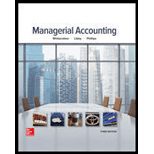
Managerial Accounting
3rd Edition
ISBN: 9780077826482
Author: Stacey M Whitecotton Associate Professor, Robert Libby, Fred Phillips Associate Professor
Publisher: McGraw-Hill Education
expand_more
expand_more
format_list_bulleted
Question
Chapter 4, Problem 4.1GAP
To determine
Activity Based Management (ABM):
Activity-based costing is a technique used to apportion the production
Total Quality Management (TQM):
TQM is a management process to benchmark all the production processes for improving quality and reduce costs periodically.
To discuss:
The successful implementation of ABM and TQM within such manufacturing organizations.
Expert Solution & Answer
Want to see the full answer?
Check out a sample textbook solution
Students have asked these similar questions
MCQ
A company's balance sheet shows total assets of $62,500 and total liabilities of $37,800. What is the amount of equity? What is the amount of net assets?
Need help with this financial accounting question not use ai
Chapter 4 Solutions
Managerial Accounting
Ch. 4 - What is the difference between a volume-based cost...Ch. 4 - Explain the statement that traditional costing...Ch. 4 - Prob. 3QCh. 4 - How does activity-based costing differ from...Ch. 4 - What types of business might use activity-based...Ch. 4 - Prob. 6QCh. 4 - Prob. 7QCh. 4 - Prob. 8QCh. 4 - Why must costs be classified into different...Ch. 4 - Prob. 10Q
Ch. 4 - Prob. 11QCh. 4 - Explain the difference between the activity-rate...Ch. 4 - Define activity-based management and explain how...Ch. 4 - Prob. 14QCh. 4 - Prob. 15QCh. 4 - What is non-value-added activity. Considering the...Ch. 4 - Prob. 17QCh. 4 - Prob. 18QCh. 4 - Prob. 19QCh. 4 - Prob. 20QCh. 4 - Prob. 1MCCh. 4 - Both traditional and ABC cost systems focus on...Ch. 4 - Prob. 3MCCh. 4 - Number of setups is an example of a a. Unit-level...Ch. 4 - Prob. 5MCCh. 4 - Prob. 6MCCh. 4 - Prob. 7MCCh. 4 - Prob. 8MCCh. 4 - Prob. 9MCCh. 4 - Prob. 10MCCh. 4 - Prob. 1MECh. 4 - Prob. 2MECh. 4 - Prob. 3MECh. 4 - Identifying terms in ABC and ABM Use the following...Ch. 4 - Prob. 5MECh. 4 - Prob. 6MECh. 4 - Assigning Costs Using Activity Proportions Refer...Ch. 4 - Calculating Activity Rates for ABC System Lakeside...Ch. 4 - Prob. 9MECh. 4 - Prob. 10MECh. 4 - Prob. 11MECh. 4 - Prob. 12MECh. 4 - Classifying Activities According to Level,...Ch. 4 - Prob. 2ECh. 4 - Prob. 3ECh. 4 - Assigning Costs Using Activity Rates Refer to the...Ch. 4 - Prob. 5ECh. 4 - Prob. 6ECh. 4 - Prob. 7ECh. 4 - Prob. 8ECh. 4 - Prob. 9ECh. 4 - Prob. 10ECh. 4 - Comparing Traditional Costing Systems and...Ch. 4 - Prob. 12ECh. 4 - Prob. 13ECh. 4 - Prob. 14ECh. 4 - Prob. 15ECh. 4 - Identifying Value-Added and Non-Value-Added...Ch. 4 - Prob. 17ECh. 4 - Prob. 18ECh. 4 - Calculating Target Cost Majesty Company uses...Ch. 4 - Assigning Costs using Traditional System, ABC...Ch. 4 - Assigning Costs using Traditional System, ABC...Ch. 4 - Prob. 1.3GAPCh. 4 - Prob. 1.4GAPCh. 4 - Prob. 1.5GAPCh. 4 - Prob. 2.1GAPCh. 4 - Prob. 2.2GAPCh. 4 - Prob. 2.3GAPCh. 4 - Prob. 2.4GAPCh. 4 - Prob. 2.5GAPCh. 4 - Prob. 3.1GAPCh. 4 - Prob. 3.2GAPCh. 4 - Prob. 3.3GAPCh. 4 - Prob. 3.4GAPCh. 4 - Prob. 3.5GAPCh. 4 - Prob. 3.6GAPCh. 4 - Prob. 3.7GAPCh. 4 - Prob. 3.8GAPCh. 4 - Prob. 4.1GAPCh. 4 - Describing the Impact of ABM and TQM on a Company...Ch. 4 - Prob. 4.3GAPCh. 4 - Prob. 4.4GAPCh. 4 - Describing the Impact of ABM and TQM on a Company...Ch. 4 - Prob. 4.6GAPCh. 4 - Prob. 4.7GAPCh. 4 - Prob. 4.8GAPCh. 4 - Prob. 5.2GAPCh. 4 - Prob. 1.1GBPCh. 4 - Prob. 1.2GBPCh. 4 - Prob. 1.3GBPCh. 4 - Prob. 1.4GBPCh. 4 - Prob. 1.5GBPCh. 4 - Prob. 2.1GBPCh. 4 - Prob. 2.2GBPCh. 4 - Prob. 2.3GBPCh. 4 - Prob. 2.4GBPCh. 4 - Prob. 2.5GBPCh. 4 - Prob. 3.1GBPCh. 4 - Selecting Cost Drivers, Assigning Costs using...Ch. 4 - Prob. 3.3GBPCh. 4 - Prob. 3.4GBPCh. 4 - Prob. 3.5GBPCh. 4 - Prob. 3.6GBPCh. 4 - Prob. 3.7GBPCh. 4 - Prob. 3.8GBPCh. 4 - Prob. 4.1GBPCh. 4 - Prob. 4.2GBPCh. 4 - Prob. 4.3GBPCh. 4 - Prob. 4.4GBPCh. 4 - Selecting Cost Drivers, Assigning Costs Using...Ch. 4 - Prob. 4.6GBPCh. 4 - Prob. 4.7GBPCh. 4 - Prob. 4.8GBPCh. 4 - Defining Concepts of Target Costing, Just-in-Time,...Ch. 4 - Defining Concepts of Target Costing, Just-in-Time,...
Knowledge Booster
Learn more about
Need a deep-dive on the concept behind this application? Look no further. Learn more about this topic, accounting and related others by exploring similar questions and additional content below.Similar questions
- The direct material price variance isarrow_forwardBradford Enterprises estimated manufacturing overhead for the year at $350,000. Manufacturing overhead for the year was underapplied by $15,000. The company applied $300,000 to Work in Process. The amount of actual overhead would have been_____.arrow_forwardWhat was its charge for depreciation and amortization of this financial accounting question?arrow_forward
arrow_back_ios
SEE MORE QUESTIONS
arrow_forward_ios
Recommended textbooks for you
 Managerial AccountingAccountingISBN:9781337912020Author:Carl Warren, Ph.d. Cma William B. TaylerPublisher:South-Western College Pub
Managerial AccountingAccountingISBN:9781337912020Author:Carl Warren, Ph.d. Cma William B. TaylerPublisher:South-Western College Pub Cornerstones of Cost Management (Cornerstones Ser...AccountingISBN:9781305970663Author:Don R. Hansen, Maryanne M. MowenPublisher:Cengage LearningPrinciples of Accounting Volume 2AccountingISBN:9781947172609Author:OpenStaxPublisher:OpenStax College
Cornerstones of Cost Management (Cornerstones Ser...AccountingISBN:9781305970663Author:Don R. Hansen, Maryanne M. MowenPublisher:Cengage LearningPrinciples of Accounting Volume 2AccountingISBN:9781947172609Author:OpenStaxPublisher:OpenStax College Managerial Accounting: The Cornerstone of Busines...AccountingISBN:9781337115773Author:Maryanne M. Mowen, Don R. Hansen, Dan L. HeitgerPublisher:Cengage Learning
Managerial Accounting: The Cornerstone of Busines...AccountingISBN:9781337115773Author:Maryanne M. Mowen, Don R. Hansen, Dan L. HeitgerPublisher:Cengage Learning

Managerial Accounting
Accounting
ISBN:9781337912020
Author:Carl Warren, Ph.d. Cma William B. Tayler
Publisher:South-Western College Pub

Cornerstones of Cost Management (Cornerstones Ser...
Accounting
ISBN:9781305970663
Author:Don R. Hansen, Maryanne M. Mowen
Publisher:Cengage Learning

Principles of Accounting Volume 2
Accounting
ISBN:9781947172609
Author:OpenStax
Publisher:OpenStax College

Managerial Accounting: The Cornerstone of Busines...
Accounting
ISBN:9781337115773
Author:Maryanne M. Mowen, Don R. Hansen, Dan L. Heitger
Publisher:Cengage Learning
Ethical Decision Making in Management; Author: GreggU;https://www.youtube.com/watch?v=6UrBO-cL27Q;License: Standard Youtube License